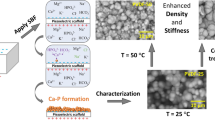Abstract
THE piezoelectric property of connective tissue may play a role in regulating the patterns of tissue growth1. Most piezoelectric measurements, however, deal with dried tissue2–4. Observations of stress-generated voltages from hydrated connective tissue are generally insufficient to establish that the voltages are of piezoelectric origin, because of complications resulting from streaming potentials and electrode effects5–7. A report of the non-existence of piezoelectricity in hydrated collagen at room temperature8 has been criticised9. Use of the converse effect is most desirable in studying biological piezoelectricity9, but for hydrated tissue the high electrical conductivity of water interferes with the establishment of an electric field inside the sample2,4. We therefore hydrated and then froze our connective tissue samples taking advantage of the reduced conductivity of ice compared with that of water. Our results establish the existence of the piezoelectric effect in bone and tendon under physiological conditions of moisture, but at a non-physiological temperature (−25° C).
Similar content being viewed by others
References
Marino, A. A., and Becker, R. O., Nature, 213, 267 (1967).
Fukada, E., and Yasuda, I., J. phys. Soc. Japan, 12, 1158 (1957).
Shamos, M. H., and Lavine, L. S., Nature, 213, 267 (1967).
Marino, A. A., and Becker, R. O., Calc. Tiss. Res., 14, 327 (1974).
Bassett, C. A. L., and Pawluk, R. J., Science, 178, 982 (1972).
Cochran, G. V. B., Pawluk, R. J., and Bassett, C. A. L., Clin. Orthop., 58, 249 (1968).
Anderson, J. C., and Eriksson, C., Nature, 227, 491 (1970).
Anderson, J. C., and Eriksson, C., Nature, 218, 166 (1968).
Liboff, A. R., and Shamos, M. H., in Biological Mineralization (edit. by Zipkin, I.), (Interscience, New York, 1973).
Marino, A. A., and Becker, R. O., Clin. Orthop., 100, 247 (1974).
Reinish, G. B., and Nowick, A. S., Nature, 253, 626–627 (1975).
Author information
Authors and Affiliations
Rights and permissions
About this article
Cite this article
MARINO, A., BECKER, R. Piezoelectricity in hydrated frozen bone and tendon. Nature 253, 627–628 (1975). https://doi.org/10.1038/253627a0
Received:
Published:
Issue Date:
DOI: https://doi.org/10.1038/253627a0
- Springer Nature Limited
This article is cited by
-
The electromechanical properties of fluid-filled bone: A new dimension
Journal of Materials Science: Materials in Medicine (1991)
-
Induced electric and magnetic fields due to wave propagation in a tubular bone
Journal of Mathematical Biology (1988)
-
Piezoelectric properties of bone as functions of moisture content
Nature (1975)





